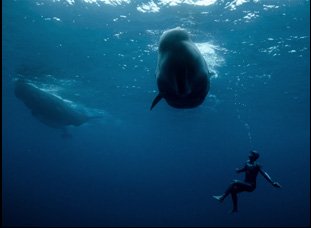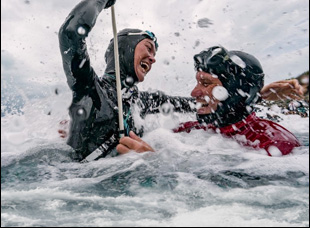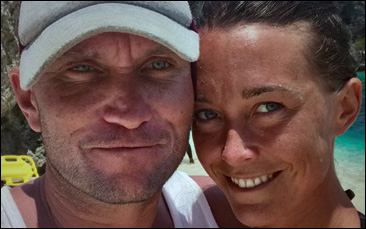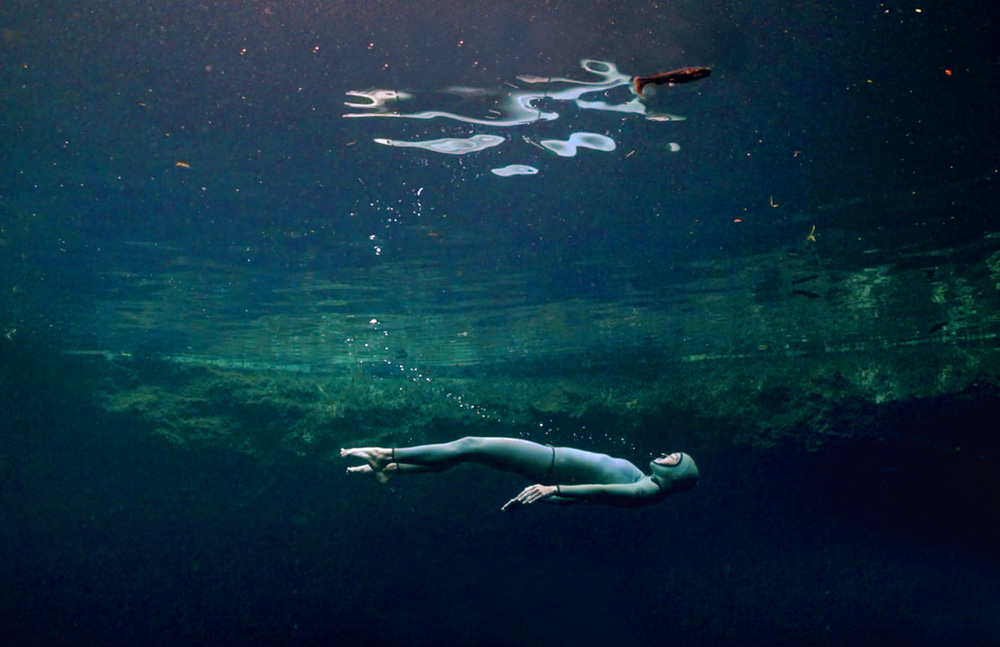There are depths that only Alessia Zecchini could ever know in her pursuit of the world record for free diving. Although when she did become the first to break the barrier of 100 meters underwater using the strength of her arms alone, it would be inevitably noted as an individual achievement, but as director Laura McGann observed in spite of a fortitude that few others could imagine, Zecchini doesn’t do this alone, with a support team circling the waters ready to revive her and that she had company on the dive itself when for any endeavor of this nature requires a rescue diver, akin to a dance partner that mirrors the majority of moves Zecchini makes. For years, that person was Stephen Keenan, who connected with Zecchini as much on dry land as he did in the water and as one of their closest confidants tells McGann, “Some people have an understanding — you don’t need words.”
Their closeness – to one another and to the water – is untangled in McGann’s enthralling new film “The Deepest Breath,” showing how both were called to the diving mecca of Dahab, Egypt by a sense of adventure, with Keenan once known to pick travel destinations by what he had seen in National Geographic Magazines and Zecchini beckoned by a cave off the coast of the Red Sea known as the Blue Hole, and wasting no time in demonstrating how their passion had them flirting with danger. Opening with a scene that is bound to take an audience’s breath away when Zecchini is struggling for air herself, having surrendered to the sea to burrow into its lowest reaches, it feels as if you’re watching a scene from “Flatliners,” when in order to make the dive just a little deeper, she’s willing to give up the comfort of exhaling just a little longer and she trusts herself to come back to as her body seizes upon reaching the surface.
“The Deepest Breath” marvelously extrapolates a recounting of how Zechinni is saved in more ways than one from this moment of unconsciousness, as those closest to her and Stephen from their fathers Enzo and Peter, respectively, to fellow free divers such as William Trubridge and Hanako Hirose paint a picture of them when they themselves have reached places only a handful of people have ever even seen with their own eyes. As exquisitely reconstructed as their experience is through interviews, archival footage and some impressive underwater recreations, “The Deepest Breath” plunges viewers into more unexpected territory as it shows the discipline required to pursue such seemingly impossible feats and the inevitable swirl of emotions it stirs up, especially when tragedy strikes, and while it appeals to all the senses with immersive sound and beautiful aquatic imagery, McGann aims straight for the heart with the beautiful love story at its core.
Following the film’s premiere at Sundance earlier this year, “The Deepest Breath” is now premiering on Netflix and McGann spoke about how she came to understand subjects who pushed themselves to the limits of what’s humanly possible, structuring the narrative to mirror her own sense of surprise through the process of research and the rewarding end result.

Initially, I was really stunned by the images that I saw — people holding their breath under the water for extended periods of time, behaving more like seals and dolphins than human beings and it was shot by cinematographers who were also free diving, so there was a real fluidity to it. It wasn’t leadened down with scuba tanks. They were able to really move at speed with the free divers. So I was struck visually, but I was also interested in getting to know more about Stephen and Alessia and when I met with Peter, Stephen’s dad, he gave me these 13 hours of interviews with Stephen, and I always use the example of “Princess Bride,” where the granddad is telling the grandson the story of this great adventure.. [Those recordings] were like that. I was like a kid listening to someone exploring the world and what they saw with their own eyes. [Stephen] was an incredible storyteller and I was just immediately hooked.
One of the extraordinary things that I wouldn’t want to spoil is how you gradually reveal Alessia and Stephen in a literal way – it takes a while to see their faces and you allow others to speak about them before their voices start to become central. Structurally, was this difficult to figure out?
Very early on when I learned that there was these amazing audio recordings of Stephen, I knew that I wanted to try and tell the story in the present, and that Stephen would be able to tell his own story through this audio and I decided fairly early on that we would treat Alessia in the same way. Stephen had also shot a lot of amazing DV footage on his camera, and I thought [due to] the nature of Stephen and Alessia, with their [own] curiosity — I wanted to give the audience the opportunity to go on this journey with them, so we’d just be in the moment with Stephen and Alessia, rather than looking back, telling the story in a way where we already know what happens, the same as the way I did when I was listening to the tapes, not necessarily knowing where life is going to take them.

Entirely different. It was a film that’s predominantly made up of archives, and it’s a story that had already happened before I came to it, but we had amazing opportunities to film in really beautiful parts of the world for all of the interviews, which we wanted to feel like they were in the same place as the archive, so you weren’t being like taken out. [I didn’t want the setting for those to] be a library or a dark space. We wanted to feel the sea just off camera or in the background. Then with the opportunity to film some underwater stuff, as a filmmaker, there was a lot to really get my teeth into because it was so much incredible archive, but there was also this underwater filming element, which I’d never done before either, so a lot was new for me.
I understand before doing the interviews for the final film, a lot of these conversations were happening over Zoom when the pandemic was preventing sit-downs. What was it like actually getting out into the world after doing all this groundwork?
I’ve never felt so prepared for interviews in my life because we really dissected the story beat by beat before we shot anything and we knew exactly what we wanted to cover and who was going to speak to each moment. Everybody was in lockdown for COVID, so we did lots and lots of research interviews and then it was getting to actually go out and fulfill what would be like a wishlist that you have and to see it come into fruition. Actually Sarah, one of our producers, said to me yesterday that she went back and read the [initial] treatment recently and we’ve pretty much made the film that we set out to make, which is a rarity. We didn’t interview Enzo until the very, very end, and Enzo was such an integral part to the story, we didn’t know that we would have what we wanted to have until the very last minute, but we were always hopeful, and certainly going out into the real world is different to just chatting on Zoom.

By going to the locations where a lot of the events happened, I was able to get a deeper understanding of why freedivers do what they do. One of the occasions that this was really important, and I’ll always be grateful for this experience as a human being was when when I was at the Blue Hole in Dahab, and the Blue Hole is like 10 meters off the shore, so you can walk into it. It’s quite shallow, only up to your hip, but there’s coral there, so you don’t walk into it, you just swim into it and I had my snorkel on and I was swimming out, looking at the little fish and all of a sudden, the ground just drops out of nowhere. I was looking down at the time and it just fell to 100 meters and all you see is this blast of stunningly bright blue. I remember somebody said to me, “The blue just calls you down,” and I got to see that with my own eyes and feel that in my body and really get a sense of how a freediver might feel when they’re about to go down. That was something that I definitely learned by being in that exact place.
One of the ways you actually bring viewers into that same experience is with some exquisite sound design where I understand you were having to replicate sounds that actually can’t be currently captured by humans. What was that like to put together?
That was a joy to have such a creative process and trying to imagine what it sounds like at a hundred meters [down] is like trying to imagine a color you’ve never seen. The free divers often say that you hear your heartbeat in your ears because they’re almost blocked with the pressure of the water. But we wanted to hear the evolution in each scene of what it sounds like when you’re at 10 meters, 20, 30, 40, and also to have a sense of what the dark sounds like and what you might hear 100 meters down if you’re afraid versus what you might hear if you’re very relaxed. Each scene under the water has a different tone and a different feeling and we wanted the soundscape to really reflect that as well. Julian Hart, our editor, did an incredible job on that, but also our sound team in Molinère — everything was used, and even just a monophone at 10 meters and the sound of a monophone at 70 meters sound different. Getting to explore that was fascinating.
Another really fascinating part of the process was creating a sound for Stephen and a sound for Alessia that myself and Nainita Desai, our composer, felt was true to them, but also even though they were different sounds, it had to feel like the film had a sound as well. Once we cracked what that was, the most enjoyable part of it was actually when Stephen and Alessia meet, and the two musical sounds come together, and there’s like a call and response from the two musical sounds as they start to weave together. That’s the scene where they’re underwater together and communicating without speaking, and it’s probably my favorite track on the film.

It was nerve-wracking, even though every decision I made during the making of the film, I had very much Stephen’s family, Peter and Alessia in mind. At the same time, I also wanted to make a very truthful account of what happened and three years of work had gone into this and here was our most important audience — Stephen’s family and Alessia and her family — and it was important to me that they were glad that they gave what they gave to this film. Thankfully, when myself and Jamie, one of our producers, sat down with Peter in his home in Dublin and Gary, Stephen’s brother, and Elaine, his stepmom and some other members of the family, Peter said just that he thought it was a beautiful and fair telling of the story. Then myself and John Battsek and Sarah Thompson went over to Rome to show Alessia and her boyfriend and Enzo, and Alessia, after she took a moment, just turned around to me and gave me a hug and said “Thank you.”
Of course, I burst into tears, but shortly after that, Alessia asked me to give her a copy of it so that she could give it to some of her people in her life so that they could see or understand what she went through without her having to tell them. I was just so glad, because she gave so much to this project, that the film would be useful for her and that she would get something in return. That was when it really felt like our jobs were done.




